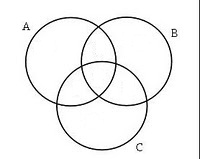
You: (A),
me: (B),
us: (A) ∪ (B),
we: ((A) = (B)) & ((A) ∪ (B)),
it’s getting weird: (((A) = (B)) & ((B) = (A))) & ((A) ∪ (B)),
fate to be determined: (((A) = (B)) & ((B) = (A))) & (((A) ∪ (B)) = ((B) ∪ (A))).
[arriving at a logical conclusion: (((A) ∪ (B)) & ((B) ∪ (A))) & (((A) = (B)) & ((B) = (A)))
{which dulls the point to the permutations of: (((B) ∪ (A)) & ((A) ∪ (B))) & (((B) = (A)) & ((A) = (B)))}]
Is our mutual fate to be determinered? If I were to have any say in the matter, I would ask that we all keep it pre-weird. Pre-we, even. It’s easier that way. I like us, (Undeterminered) =|= (Undefined), and thence, not terminated, where the proposed operator [=|=] can be used, when(A) and (B) not = (0), as
- ((A) =|= (B)) =
- (Is it true that (A) and (B) are the same, or what?) =
- ((A) is possibly the same as (B).) =
- (I think (A) and (B) are the same but I have to find out with covariably moving operating elements.) =
- ((c)[dulls](B)[from](A)[due to](b)), with (b) ∈ (B) only becoming an operant element (c) ∈ (B) once the possibly offendingly nullificatory operative element (b) is sufficiently known to be described with (c) being placed in quantity (B).
All of that is to say: By refusing to determine something, we leave it undefined, in the hopes that some errant detail or element of the parties involved doesn’t lead to catastrophe. All the while keeping in mind that, because it takes enough time to perform calculations to compare sets of elements, due to the uncountability of their components, there might even be differing elements contained within (A) and (B) in quantities so large that the order of operations matters in the performance of the comparison, even if the quantities are believed to be the same. If you were to try comparing every star in the sky to every other star in the sky, for example, you would probably die from old age before your life’s work was completed.
A reason we find the need for attentiveness to order of operations is because the very meaning of the discrete lexical quantity
is not solely restricted to
- (A mathematical definitional tool used to perform set operations),
thereby necessitating a linguistic delineation for each possible definition. We may relate each definition to
each definition imbued with semantic meaning, in order to create a variable set notation for each possible reading. Each reading can be said to consist of subset morphemes, respectively
- (a1, a2, …),
- (b1, b2, …),
- (…),
and while we may ultimately find it less restrictive, and more easily proven, that
with (A) and (B) containing all possible elements, is true, that’s simply because it is always the case. Nevertheless, with linguistic parameters in mind, “determinered” can be defined opposingly as either
or
or
- (made into a mathematically defined quantity using set theory),
necessitating a closer examination of the word in question.
We often find that defining something leads to the extinction of the defined quantity, just as frequently as the extinction of definitional work undertaken, which is the opposite of
(determination) = (the opposite or ceasement of termination). The term itself is made roughly of the morphological roots (de) + (term) + (minus) + (nate) + (ed), which indicate the quantity resulting from a full term of some continuing action from a beginning point to an ending, or possibly even an unending, boundary. This begs the question: What does one do when the language being used flies in the face of the quantity being described, and what does one do in regards to the contradiction of thought and word meaning when words are conglomerated in a way that creates confusion, as this conglomeration is often wont to grow long and unwieldly and meaningless by it’s nearness to the logical tools by which it is both operating and being operated upon? Exempli grati:
- What to do with one of the many logic-thread return operation endpoints of a single subroutine of an asynchronous multi-routine software program, running on an independently-operated computational processing terminal, wired as a node of a distributed, multi-device, multi-frequency computer processing network’s transmission network, linked with a second, differently-schemed and operated network, within a continuously unifying and disparately refreshing computing framework, returns a variantly true logical value? (Edit 03/18/2014: See also: http://recode.net/2014/03/18/microsoft-researcher-wins-nobel-prize-of-computer-science/)
- Balancing an ecosystem of animals and plants containing multiple species that possess varying predators, prey, reproduction rates with a single new species whose interactions must be compared to each member species of the existing ecosystem before its impact on the entire system can be projected, while territorial, predatory, and sexual interactions are already taking place, and projections indicate will continue to impact the ecosystem chaotically, even taking into account the effects of the projectionists themselves.
- Uninstalling and removing a part from a closed machine that’s internally needed for taking apart the machine in itself.
- If you can’t read this text, your computer is not good enough to translate it.
- “This statement is false.” as a logical assertion describing it’s own truth value

Applicatorily, I would suggest sorting and prioritizing lists of repair elements before or during processing work to make sure nothing unwanted happens, such as calculation or processing time-mismatches or nullification of sets or elements, when reinforcing, altering, inclusivating, or diminishing a set quantity such as the aforementioned (B) in a motive system, especially when the repairs are extensive or if you have more that a single set (or even programming function interactions such as clicking, rendering, and loading!), the goal being to minimize delta t between operations.
An abbreviation for this phenomenon is in order. Given
- (A) and (B) are sets,
- (a1, a2, …) ∈ (A), (b1, b2, …) ∈ (B),
- (A) = (B) & (B) = (A),
We will now define a syntactic function to be used under the conditions that adding an element (c) to the set (B) leads to contradiction. That is to say, when performing the operation
implies
- ((A) = (B)) & ((B) != (A)),as(c) dulls (B) from (A) due to (b) unless…X(c) | Y(c) | Z(c) | …
Where the functions X, Y, Z are defined as:
- X(c) = (((b_1 = (c^-1)), (c)) ∈ (B)) = (A) |
- Y(c) = (((b_2 = (-c)), (c)) ∈ (B)) = (A) |
- Z(c) = (((b_3) = (complement(c)), (c)) ∈ (B)) = (A),
and are defined in this capacity as methods for dealing with a contradictory outcome in order to maintain the parameter that (A) = (B).
To summarize in less formal terms, we define the term “Dulls”, to be used when (A) is the same as (B) and (B) is the same as (A), but proposing the inclusion of new information (c) in (B) causes (A) and (B) to be unequal, and implies that a previously known element (b) in (B) must be replaced by a correction of (b) in (B), or (b) must be removed entirely from (B), or an additional element (b_n) must be added to provide further proof of why there is no contradiction, all in order to maintain the equality of (A) and (B), otherwise we find that (A) is not equal to (B) when (c) has been introduced. This is to be used in situations where the quantity under discussion (B), which holds most or all of its characteristics in common with quantity (A), is dis-proving its need for use by being overwrought in relation to a more basic quantity (c) that is known and remains true to form, despite an equally well-known quantity (b) in (B), such that (A) and (B) must be reinforced, altered, inclusivated, or diminished as a result, otherwise
- (((A) = (B)) & ((B) = (A))) & (((A) ∪ (B)) = ((B) ∪ (A))) ∪ (((A) ∪ (B)) == (0)) = 0,
without more information regarding a proposed quantity (b) whose definition necessitates this, we mandate more or less of (a1, a2, …), (b1, b2, …) and imply a change of either (A) or (B) such that the nullification of either set (A) | (B) is avoided, and requirements of new definition is met and adherence to novelly-defined (c) into the previously defined sets allows the avoid having this happen.
In conclusion is a short poem regarding the initial pretext for this entire fuddled explanation:
The time it takes to say something about friendship…
until that which is being said is shared…
can only be done extensively and exhaustively…
if one hopes to succeed at both sharing and friendship,
and that’s why time is a mutually disagreed upon figment,
so I guess I could say time dulls us together,
and if it doesn’t, something is both wrong and right,
because if you are that inclusivist and harmonious, you should find yourself blaming the wrongness on anything at all, and doing anything at all to fix it,
and after all, why doth the mind and body die without sustenance, and why is that sustenance both friendship and food both for the being’s mind and body?
Thanks to John R. Durbin for being a great teacher and an excellent textbook author.
To break with reality completely,
This post has now been been determinated.




Leave a Reply
You must be logged in to post a comment.